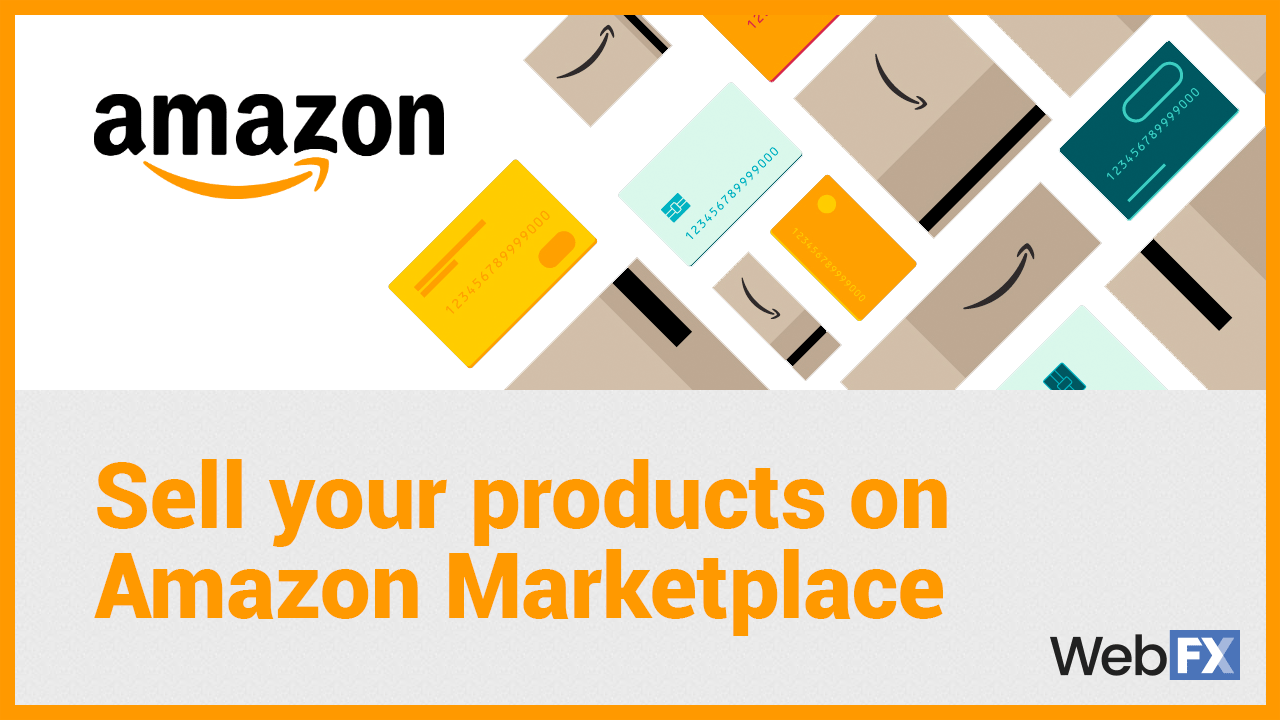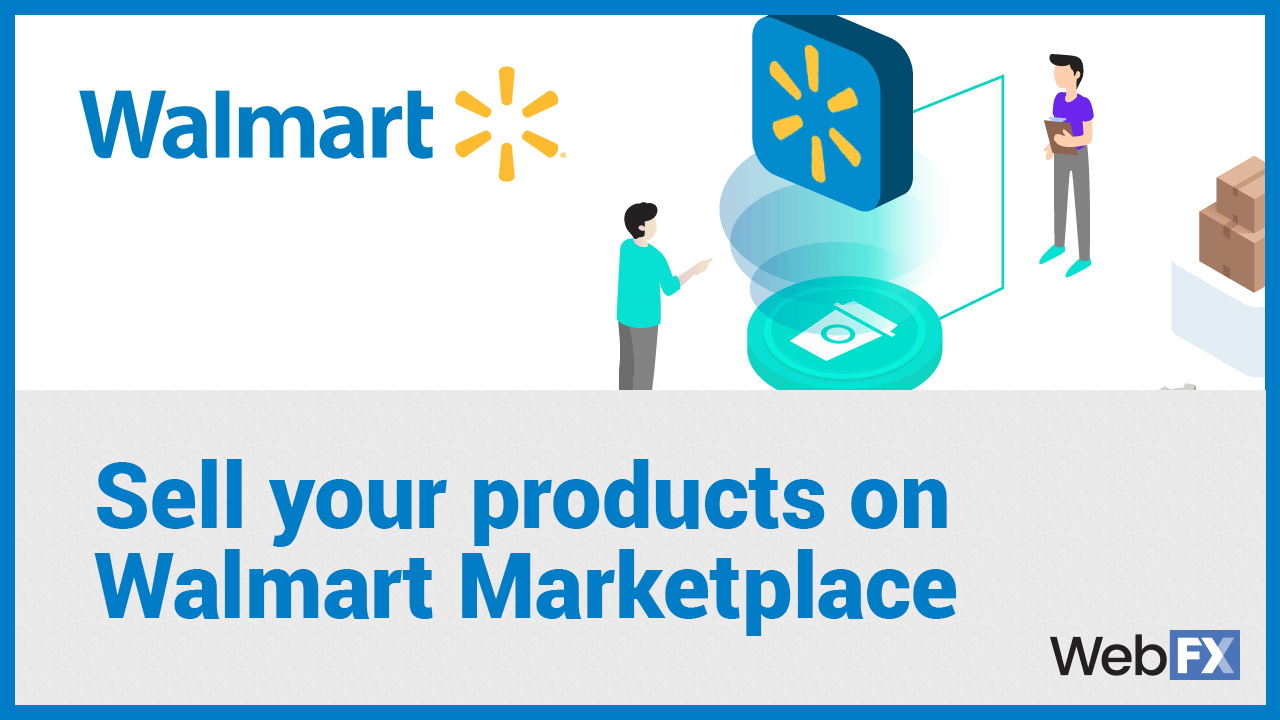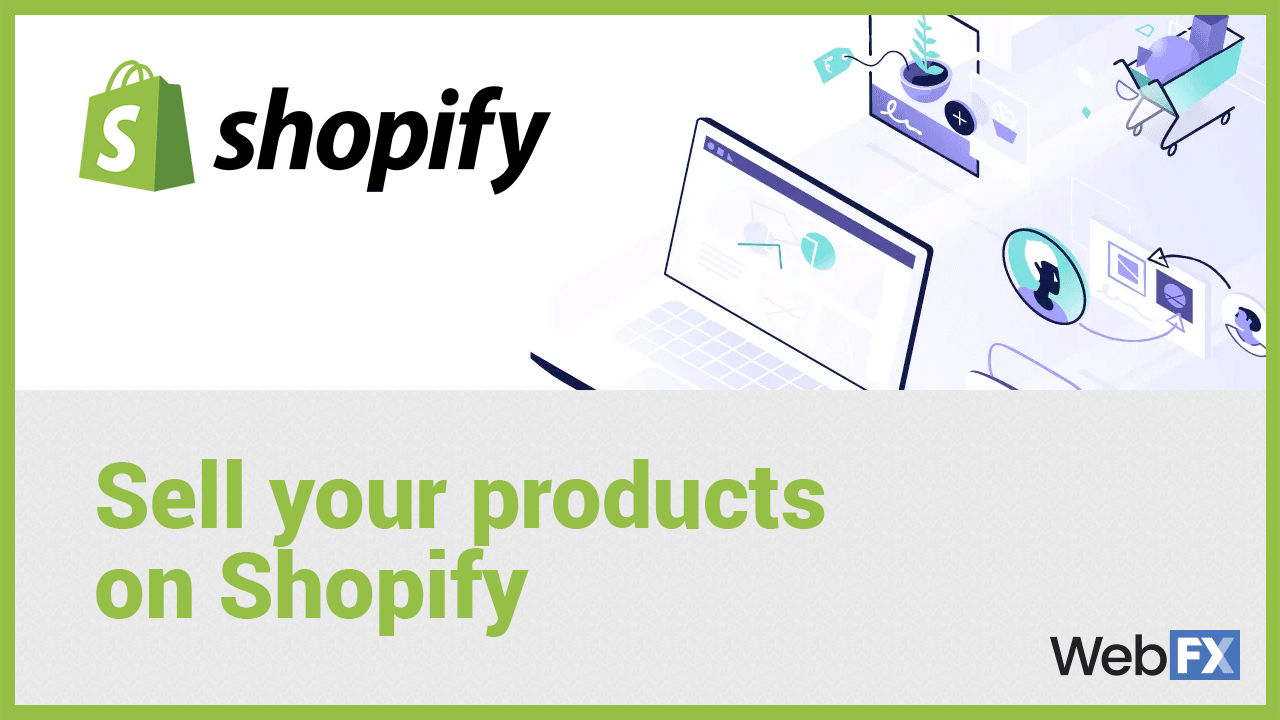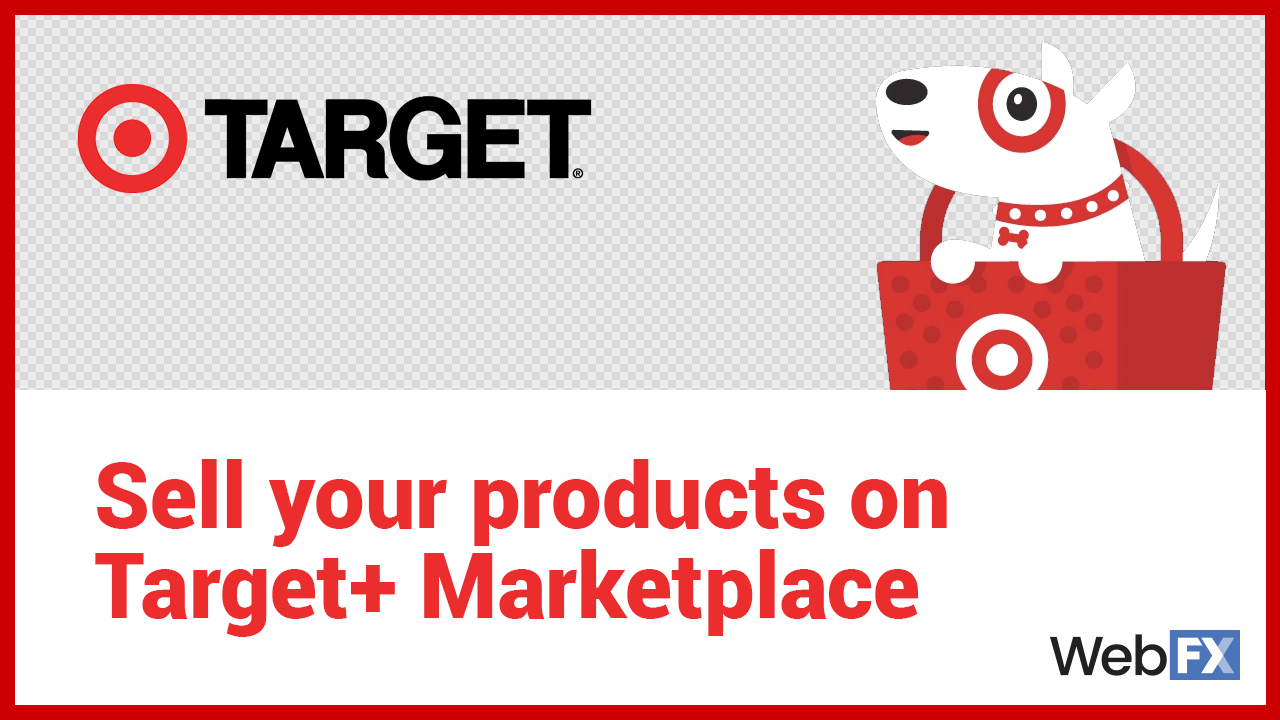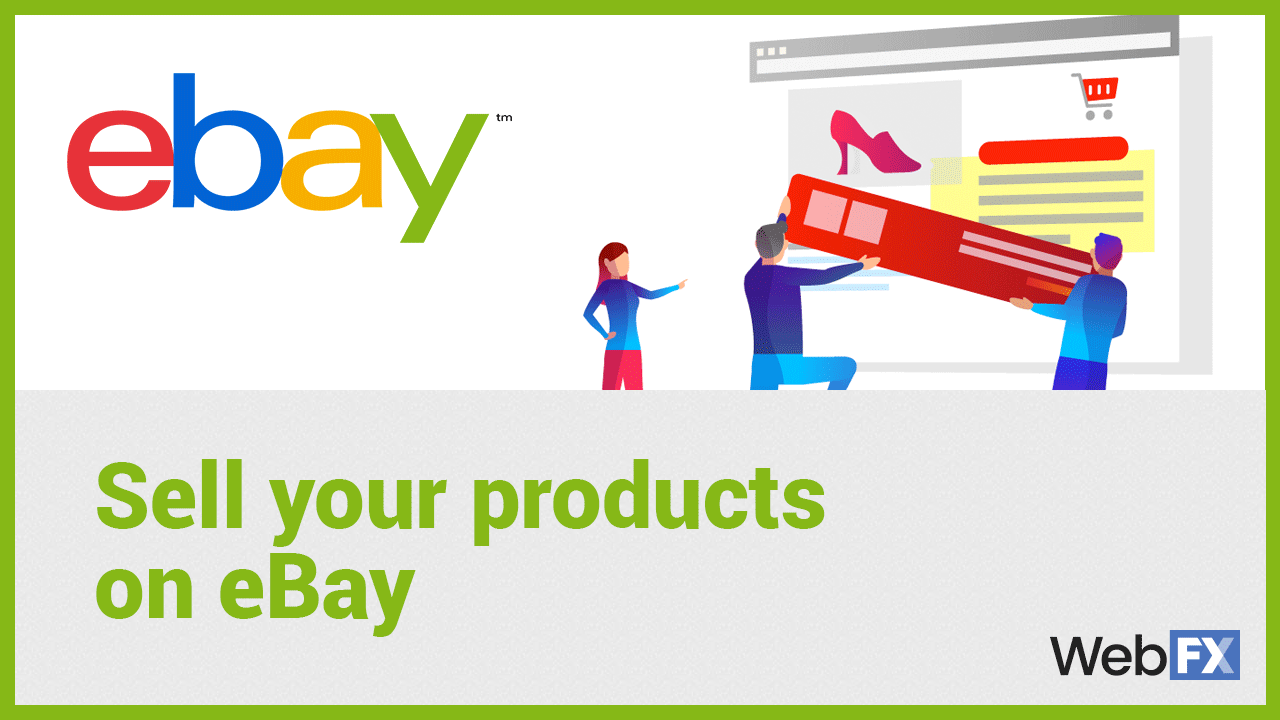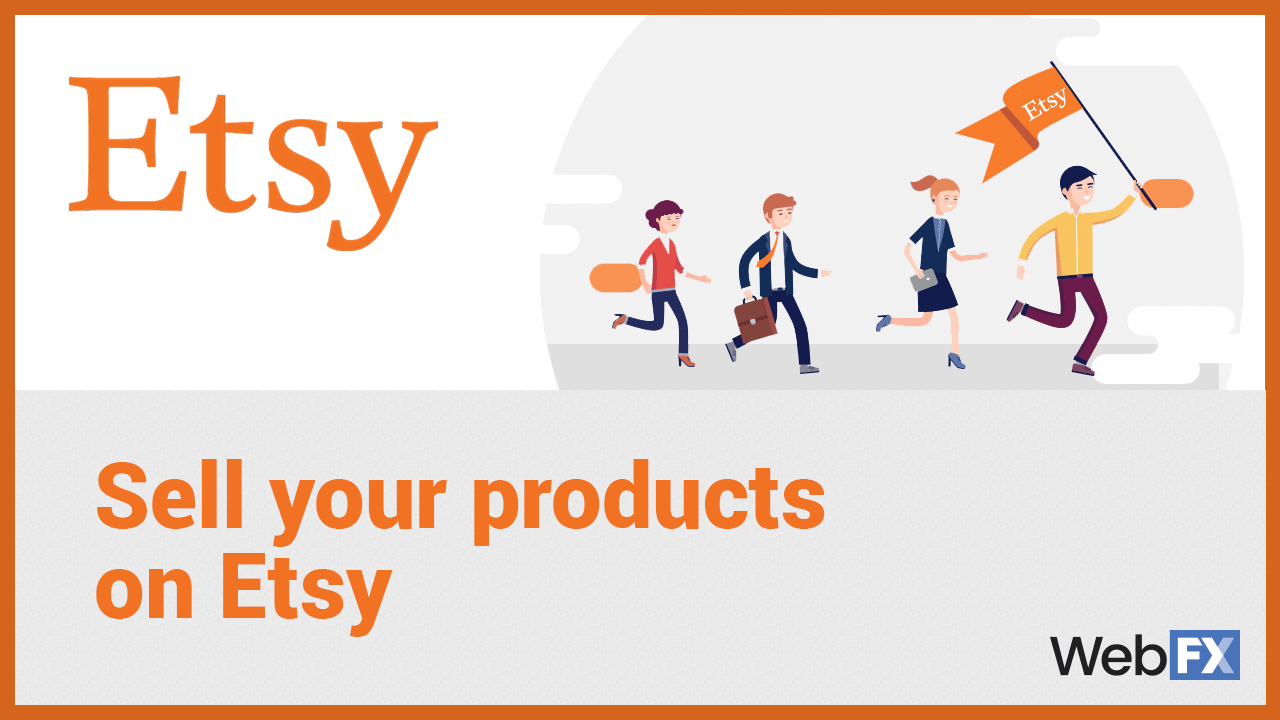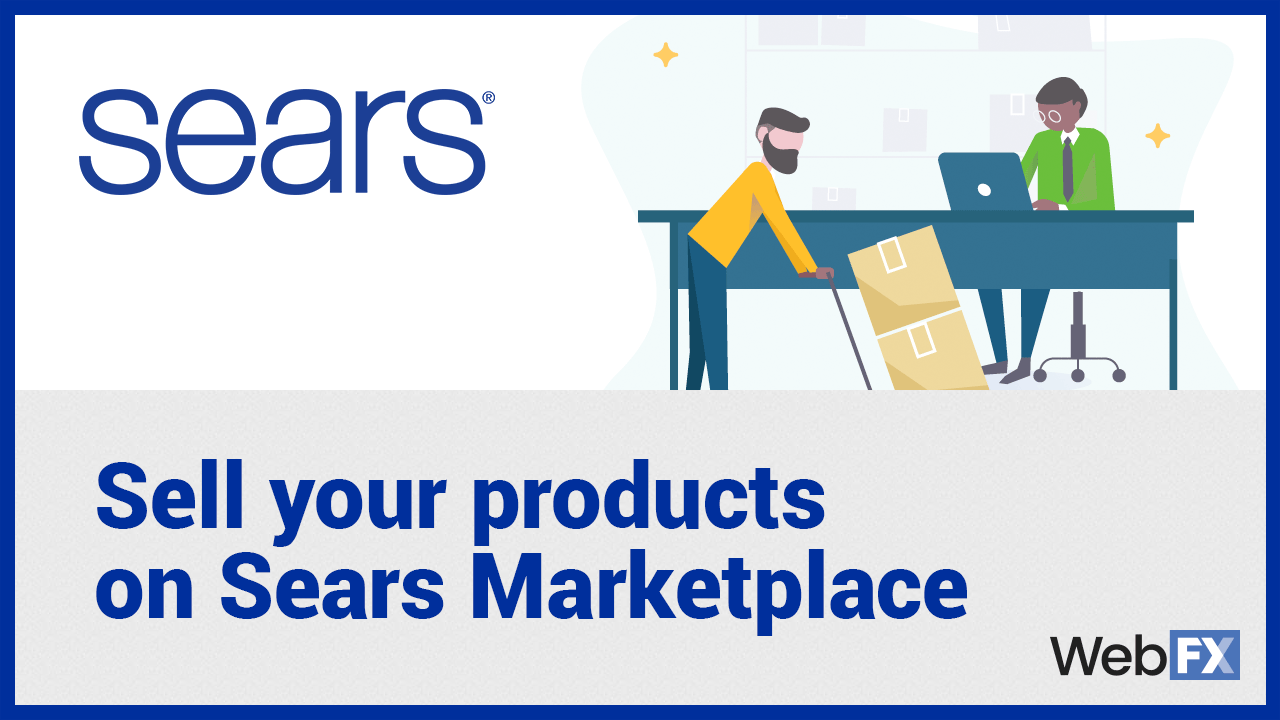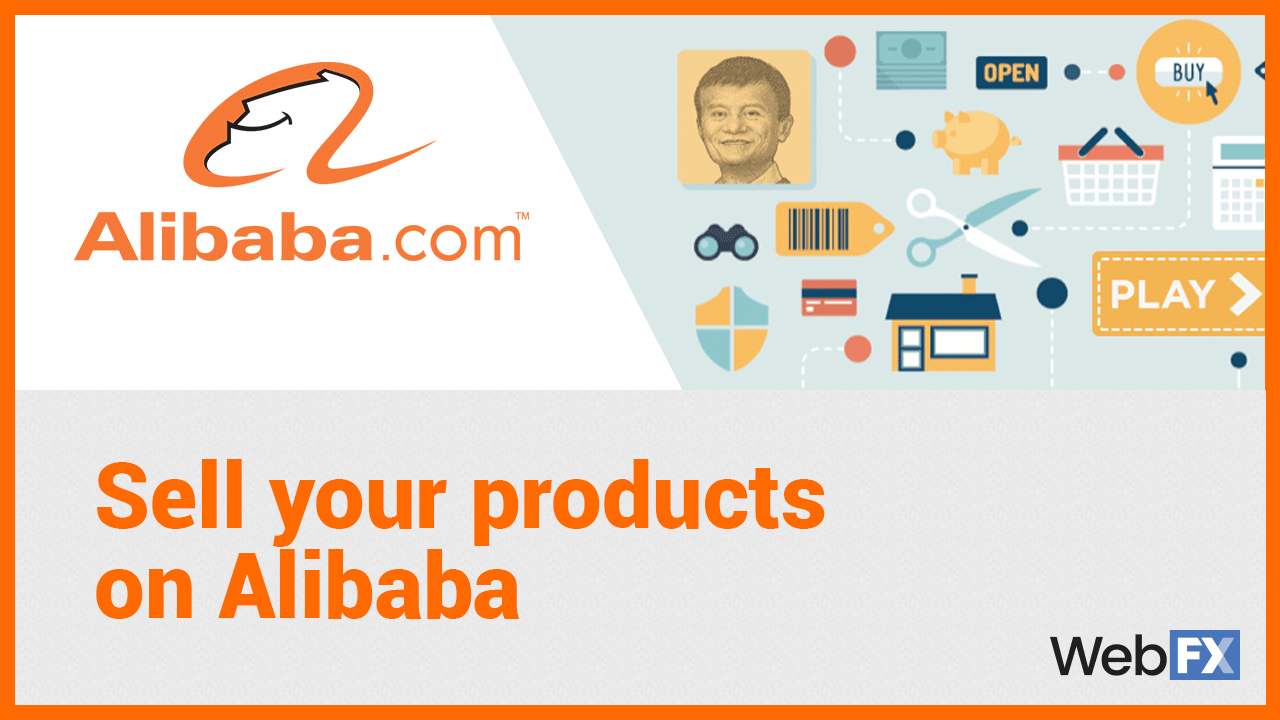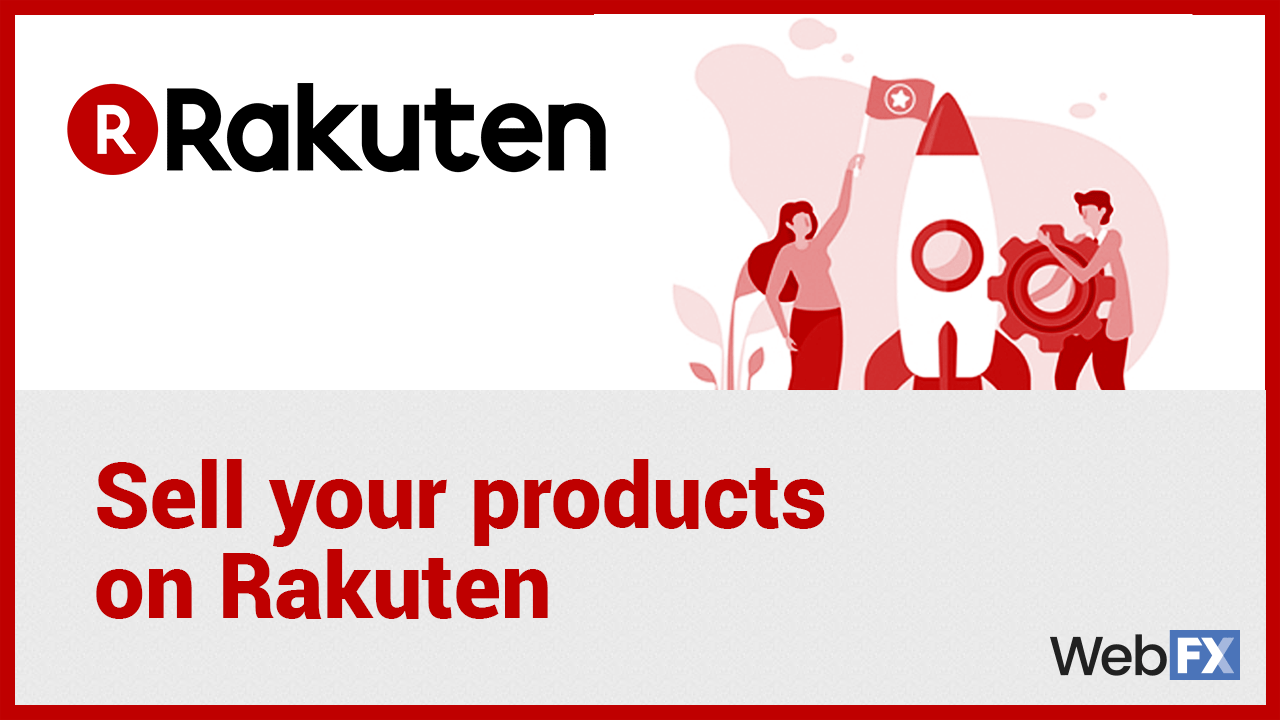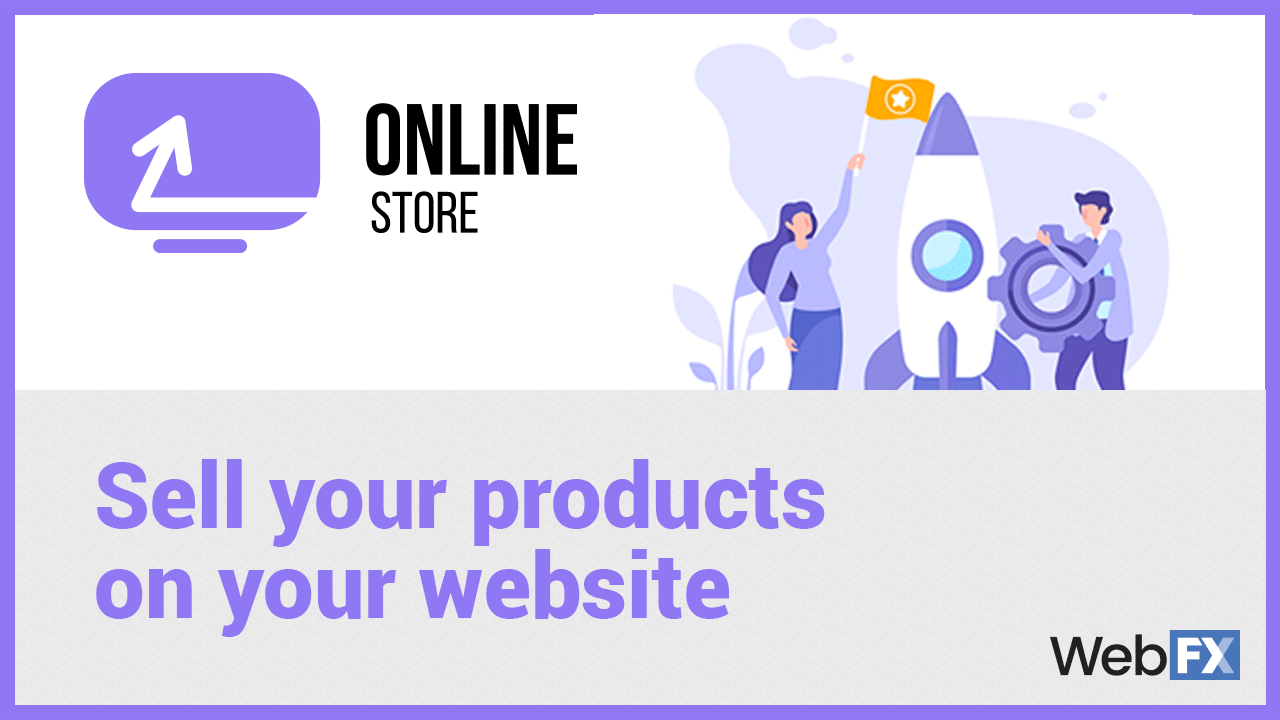Online Marketplace Guide: How to Sell Online and Where to Sell Online in 2024
How to sell online in 2024: 6 easy-to-follow steps
Not sure how to start selling your products online? Follow these six steps:
1. Choose what products to sell
Before you start selling online, you’ll need to establish a business plan and decide what items you want to sell through an online marketplace.
You may already have an established retail location for selling offline. But if you’re just starting your business, you’ll need to carefully consider what you’re going to sell.
When deciding what to sell, consider demand, potential profit margins, and your own interests.
You can use various online tools to gauge demand and come up with ideas for products to sell. Here are a few useful tools to check out:
- Google Trends: Google Trends is a tool from Google that provides data on the popularity of search terms over time. You can use this tool to see which searches are gaining popularity, enabling you to hop on product trends while they’re on the rise.
- Other keyword research tools: You can also use other keyword research tools, like SEMrush and KeywordsFX, to help you determine which product-related keywords are most popular. These tools also show you related keywords, which can give you additional product ideas.
- Social media: Browse social media sites, as well as forum and review sites, to see what products people are talking about. Also, look for problems people are mentioning that a product could help with.
- Competitor research: Research the products other online retailers, especially big-name brands, sell to see what’s selling well. See if you can uncover any trends in product types. You can also browse sites like Amazon and eBay and explore the trending pages.
You’ll also want to research your potential profit margins. Look into how much products similar to yours sell for, and estimate how much it will cost you to produce and distribute your products.
Don’t forget to consider your own interests as well! Selling products you’re excited about can keep you motivated as you figure out how to sell online.
2. Create a business plan
Every business needs a plan, including those that use online selling platforms. Creating a detailed business plan will help you determine how to sell your products online and help you reach your goals.
When creating your business plan, consider factors such as:
- Your goals: Determine what you want to achieve and create measurable goals to help you track your progress.
- Your competitors: Analyze the competitive landscape for your products. This will give you ideas for how to sell goods online in your industry and provide insight into the challenges you’ll face.
- Your audience: Determine who the target audience will be. You’ll want to tailor your products, website design, and marketing to your audience’s needs and preferences.
3. Decide where to sell online
After establishing your inventory, you’ll need to determine where to sell online.
Whether you sell on your own website or a top online marketplace, there are more options than ever for diversifying your selling channels in 2024.
Our guide outlines the pros and cons of selling on each platform, as well as your ecommerce site, so spend some time reviewing your options when deciding where to sell online.
Explore your ecommerce platform options
If you need help determining which selling platform is best for your business, WebFX can help. Connect with our ecommerce experts to learn more!
4. Build your online store
Next, you can start building your online store and listing products for sale.
If you chose to use an online marketplace, you’ll need to create an account and set up your page.
If you decide to sell on your own website, you’ll want to pick a domain name that reflects your brand and is easy to remember. Platforms like Shopify make it easy to get your online shop up and running quickly. So, keep that in mind when setting up your online site — especially if you don’t have a lot of technical expertise.
For platform-specific instructions on how to build your online store, check out the below section on where to sell online.
Selling on your online store vs. an ecommerce marketplace requires ongoing maintenance and optimization — and we recommend partnering with an ecommerce agency like WebFX to get the best results.
5. Set up ecommerce functionalities and processes
Many elements go into how to sell online, and you’ll need to set up various processes and functionalities before you launch your ecommerce store. These elements include:
Payment processing
To start selling online, you’ll need to set up payment processing.
You have numerous options for accepting online payments, whether you open a merchant account or use a payment processor like PayPal, Square, or Stripe.
Where you sell online will also impact the payment processing solution you choose.
For more info on choosing the best online payment system, check out this helpful guide.
Shipping
Next, you need to identify the shipping methods and rates you’ll offer.
Depending on your country, you may have access to USPS, FedEx, Canada Post, Royal Mail, AU Post, or other carriers.
Free shipping entices customers to buy but remember that you’ll need to absorb that cost.
Some online marketplaces — like Amazon — offer fulfillment and shipping options to help you sell more online.
So, be sure to consider all the options and rates available when determining where to sell online.
Security
No matter where you sell, you’ll want to enable secure online payments so people feel comfortable shopping on your site and purchasing from your business.
Use a payment processing system with proven security and ensure your site has a secure sockets layer (SSL) certificate.
Policies and documents
You’ll want to have several documents available on your ecommerce website. These documents include:
- Terms of use document: A terms of use document lays out rules for using your site and helps protect your business legally.
- Privacy policy: Your privacy policy also helps protect your business legally and helps you establish trust with users.
- Return policy: You’ll also need a document that describes the rules and processes for returning products. A good return policy can help establish trust with shoppers and encourage them to make purchases.
Licenses
You’ll also want to make sure you have all the necessary business licenses. Check your local, state, and federal laws to determine which licenses you’ll need.
Customer service
Ensure your customers have a way to contact you, and determine how you’ll handle customer service issues.
For more essential functionalities and other items to take care of before launching your site, check out our ecommerce checklist.
6. Promote your online business
Finally, you’ll need to market your online business, so people can easily find your site and purchase.
You can have the most beautifully designed site and world-class products, but without proper optimization and promotion, nobody will be able to find your ecommerce store or your profile on a top-selling site.
Marketing is a crucial part of how to sell goods online, so be sure to invest in digital marketing services — like search engine optimization (SEO) and website maintenance — that set your site up for long-term success.
Looking for a digital marketing partner to take your online sales to new heights? Give WebFX a call at 888-601-5359 or contact us online to learn how our ecommerce solutions can grow your business.
Related Resources
- B2C Marketplaces
- Best Ecommerce Platforms for Small Businesses
- Enterprise
- Learn About Online Marketplaces
- Online Marketplaces for Ecommerce Businesses
- Online Marketplaces Glossary
- Should I Sell on Walmart or Target? Which Online Marketplace is Best for Selling?
- What is an Online Marketplace?
- What is Sears Marketplace? [+5 Benefits of Sears Marketplace]
- 14 Best Places to Sell Online in 2024
Find Us Driving Revenue Nationwide
- Internet Marketing Agency
- Internet Marketing Prices for Every Strategy
- Marketing Operations Services
- Measure Your Product Catalog’s ROI with Ecommerce PIM
- Online Press Release Services: Promote & Grow Your Company
- Performance Marketing Agency
- Performance Marketing Services
- Professional Marketing Company
- Professional Marketing Services: Grow Your Revenue
- AI Marketing Services
Ready to Grow? Get your FREE Quote Today!
“We measure our success by how much we WOW our clients.”
Bill Craig
WebFX President
11 best-selling platforms for selling products online
When it comes to selling products online, the best-selling platforms for businesses are:
- Amazon
- Walmart Marketplace
- Shopify
- Target Plus™
- eBay
- Etsy
- Sears Marketplace
- Alibaba
- Rakuten
- Facebook Marketplace
- Your website
Keep reading for a breakdown of each online marketplace, which includes an overview of their:
- Pros
- Cons
- Cost
- Advertising options
- Shipping options
- How to get started
In most cases, businesses will benefit from selling on multiple online selling sites. If you have a dedicated website, plus a presence on Amazon, for example, that allows your company to reach more shoppers through multiple channels.
Where to sell online: Inside the 11 best online marketplaces
Now that you know how to sell online and have an overview of the best online selling sites, let’s break down the ins and outs of where you can sell your products and how to sell online with each marketplace. Use the links below if you’d like to jump straight to a specific best platform to sell online.
- Amazon
- Target Plus™
- Walmart Marketplace
- Shopify
- eBay
- Etsy
- Sears Marketplace
- Alibaba
- Rakuten
- Facebook Marketplace
- Your website
Amazon Marketplace
Amazon Marketplace ranks number one on our list of the best platform to sell online in 2024.
In the U.S. alone, more than 1 million SMBs sell on Amazon Marketplace.
It’s fairly easy to start selling on the platform, and Amazon Marketplace allows sellers to get more eyes on their products fast.
How to sell on Amazon Marketplace
Wondering how to sell online with Amazon Marketplace? Here’s how to get started:
- Decide what you want to sell. Amazon offers more than 40 product categories, plus 10 additional categories to Professional Sellers.
- Choose a selling plan. Amazon offers two options for sellers, which we’ll cover below.
- Create an account. To register your account, visit Seller Central, Amazon’s online interface for managing seller accounts.
- List your products. Individual sellers can add products to the Amazon Marketplace catalog one at a time. The Professional plan lets you add products in bulk.
If you’re listing products already on Amazon.com, you will need to indicate:
- Product quantity
- Product conditions
- Shipping options
If you’re listing products that aren’t on this selling platform yet, you’ll need to identify their UPC/EAN and SKU, as well as list product attributes like titles and descriptions.
- Start selling. You’ll receive payment directly to your bank account and receive an email notification when payment sends.
- Ship your products. Amazon will notify you when a customer places an order. You can use Fulfillment by Amazon (FBA) to let Amazon handle shipping — or take care of shipping products yourself.
- Get paid. Amazon deposits payment into your bank account at regular intervals and notifies you when it sends.
Cost of selling on Amazon Marketplace
- Individual plan: $0.99/item sold
- Professional plan: $39.99/month
With the Individual plan, sellers pay $0.99 per item sold, plus additional selling fees.
The Professional plan allows you to sell an unlimited number of products for $39.99/month with additional selling fees.
If you only sell a few products each month, the Individual plan may work for you. However, the Professional plan appeals to sellers with larger product quantities.
Amazon ad options
Amazon offers numerous ad options to help sellers reach more customers and boost online sales.
They include:
- Sponsored Products: Ads appear in search results and on product pages to improve the visibility of individual products.
- Sponsored Brands: Ads appear in search results and include your logo with a custom headline to boost brand awareness.
- Sponsored Display (beta): A self-service ad solution that allows you to reach relevant audiences on and off Amazon.
- Stores: Free, multi-page stores on Amazon to drive customer loyalty.
- Display ads: Ads that showcase your brand or product on websites, apps, and devices on and off Amazon.
- Video ads: Video ads on Amazon sites, devices like Amazon’s Fire tablets, and across the Internet.
- Custom ads: Custom ad experiences boost brand awareness.
- Amazon DSP: Amazon’s demand-side platform (DSP) provides advanced tools for buying ad placements on and off Amazon.
Amazon shipping options
When shipping your Amazon Marketplace products, you have two options — Fulfillment by Amazon (FBA) and the Merchant Fulfilled Network (MFN).
Fulfillment by Amazon (FBA)
A noteworthy perk of selling on Amazon Marketplace comes from Fulfillment by Amazon (FBA), which you can use to ship your products.
With FBA, you pay to store products in Amazon’s fulfillment centers. When a customer places an order for your FBA product, Amazon receives the info, picks the stock from the shelves, packs, and ships the item.
Amazon also provides customer service for all FBA products.
FBA fees depend on the size and weight of items sold. Amazon also charges short- and long-term storage fees, so you’ll pay more for products that stay in the FBA inventory longer.
FBA offers many benefits, including:
- Free shipping on eligible orders: FBA products are eligible for Amazon Prime’s free two-day shipping perk, as well as free shipping on eligible orders.
- Customer service and returns: Amazon handles customer service and returns for FBA products.
- Exclusive programs to expand your reach: FBA Subscribe & Save, FBA Small and Light, Multi-Channel Fulfillment, and FBA Export help sellers maximize sales and inspire repeat purchases.
- Business management tools: FBA sellers can access optional services like product preparation, labeling, repackaging, and Amazon-partnered carrier options.
How to get started with FBA
To begin using FBA, follow these steps:
- Set up FBA. If you already sell on Amazon, just add FBA to your account.
- Create product listings. Add products to the Amazon catalog one at a time, in bulk, or by integrating your inventory management software with Amazon’s API.
- Prepare your products. Check out Amazon’s packaging and prep requirements to ensure your products arrive at the fulfillment center safely.
- Ship your products to Amazon. Finally, create your shipping plan, print your Amazon shipment ID labels, and ship your products to the appropriate fulfillment centers.
If you need to convert existing inventory to FBA, you can:
- Visit the Manage Inventory page and select the products you want to sell via FBA.
- Click “Change to Fulfilled by Amazon” from the “Actions” menu.
- Select “Convert & Send Inventory” to continue creating your shipment, or choose “Convert only” to continue adding inventory.
Merchant Fulfilled Network (MFN)
If you don’t want to use FBA, you can ship products via the Merchant Fulfilled Network (MFN), also known as Fulfilled by Merchant (FBM).
MFN allows you to ship products directly from your home, business, or warehouse. Just remember — with this option, you’re responsible for locating stock, packing orders, arranging shipping, and providing customer service.
Now that you understand how selling on Amazon Marketplace works, you’re probably wondering, “Is it better to sell on Amazon or my website?”
Let’s look at some pros and cons of selling on Amazon Marketplace.
Pros and cons of selling on Amazon vs. your website
First, let’s look at some advantages of using this online selling site.
Pros:
- You can start selling fast: Amazon Marketplace allows you to start selling products online without creating a website, and you can easily manage everything from Seller Central.
- You can leverage Amazon’s traffic: In the U.S., Amazon has more than 150 million unique monthly visitors. If you just launched your website or don’t use SEO services, it’s difficult to drive that kind of traffic. Selling on Amazon can get more eyes on your products, which means you can sell more.
- You can streamline fulfillment: FBA makes inventory management and shipping processes easy for sellers. So, if you’re worried about keeping up with order fulfillment, Amazon Marketplace is an excellent option for your business.
- You can combat copycats and scammers: With the Amazon Brand Registry, you can protect your products against copycat sellers with knockoff products. Check out our Amazon Brand Registry consulting services to learn how to protect your brand!
Cons:
- You have greater competition: While Amazon gives you access to a broader audience, as being one of the best platform to sell online, you’ll also experience a higher volume of competitors. This means you’ll need to employ strategies like Amazon SEO to help your listings stand out and encourage people to buy.
- You experience fixed pricing: Greater competition also means you’ll have to monitor your pricing to remain competitive. If other sellers offer products of equal value for cheaper, you’ll likely lose sales and revenue.
- You have to pay fees: Selling on Amazon also requires you to pay a monthly fee, plus additional selling fees, which can cut into your profit.
Additional Amazon Marketplace resources
For more info on Amazon Marketplace selling and marketing, check out these resources from WebFX.
- Amazon SEO Optimization
- Guide to Selling Your Products on Amazon
- Amazon Marketing for SMBs: Everything You Need to Know
Summary
Want to boost online revenue fast? Amazon is a good option for small and midsize businesses selling a range of products like apparel, home goods, electronics, and much more!
Walmart Marketplace
Walmart Marketplace comes in second on our online marketplace ranking list.
In the U.S., 100 million people visit Walmart.com every month.
Selling on Walmart Marketplace expands your reach immediately, helping you sell more products.
How to sell on Walmart Marketplace
To get started selling on Walmart Marketplace, you’ll need to:
- Fill out an application with information about your business and products.
- Sign your contract. Sign the Retailer Agreement with a Walmart representative.
- Complete your seller profile and connect a payment account.
- Complete the onboarding process. Choose an integration method, add products, and test orders.
- Go live. Walmart will conduct a final review before giving you the green light to start selling.
Cost of selling on Walmart Marketplace
While Walmart does not charge monthly fees, sellers can expect to pay referral fees ranging from 6-20% for various product categories on this online selling platform.
For example, if you sell apparel on Walmart Marketplace, you can expect to pay a 15% referral fee.
Before you start selling on Walmart.com, you’ll have a chance to review the Product Categories and their referral fees in your Walmart Marketplace Retailer agreement.
Walmart Marketplace ad options
Select Marketplace sellers have access to the Walmart Sponsored Products program.
This program, which requires a $1000 minimum monthly ad spend, allows sellers to create native ads that appear in search results, as well as item, category, and product pages.
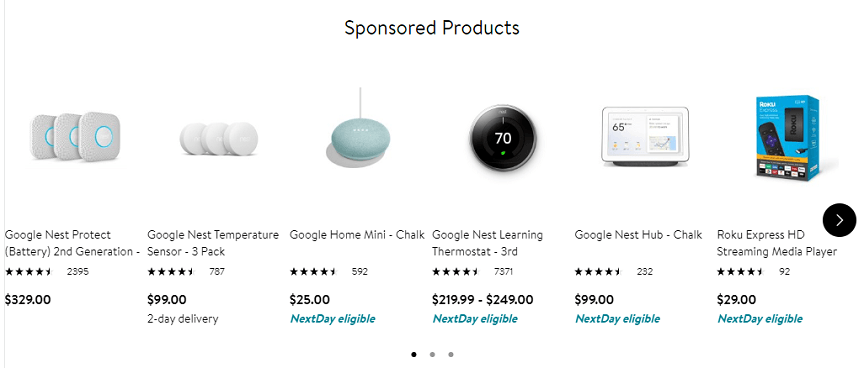
Walmart’s Sponsored Products program allows you to increase the visibility of your products without paying directly for views. Like pay-per-click (PPC) ads, you only pay when customers click on your ad. Walmart’s internal relevancy engines help determine the best time and place to make that happen.
While sellers can oversee their ad strategies in-house, Walmart offers ad management services for campaigns with budgets over $25,000.
Participation in Walmart’s Sponsored Products program requires approval and onboarding from the Walmart Media Group.
To start advertising on this selling platform, you’ll need to:
- Provide basic company details to confirm eligibility.
- Receive confirmation of successful onboarding.
- Log in to advertising.walmart.com to start advertising.
Walmart Marketplace shipping options
Walmart Marketplace offers five shipping methods, including:
- Value
- Standard
- Expedited
- Next Day
- Freight
Sellers select the carriers, shipping price, and shipping method when setting up their profile in Seller Central.
The online marketplace requires sellers to ship orders in non-branded packaging, and you can’t include materials from any company other than Walmart.
With Walmart Marketplace, sellers have access to the platform’s TwoDay Delivery option, which is a great incentive for buyers.
For more information, check out Walmart Marketplace’s shipping guidelines.
Pros and cons of selling on Walmart Marketplace vs. your website
Let’s look at some pros and cons of selling on Walmart Marketplace vs. your ecommerce site.
Pros:
- You don’t have to pay monthly fees: Unlike many other online selling sites, Walmart doesn’t charge sellers monthly, setup, subscription, or listing fees.
- You have access to Walmart’s TwoDay Delivery program: Sellers on Walmart Marketplace also have access to the platform’s TwoDay Delivery option. This incentive adds value and encourages shoppers to order.
- You can reach a broad audience: Walmart.com receives 100 million unique visitors every month. Selling on the platform allows you to reach a massive audience of consumers and boost sales for your SMB.
Cons:
- You pay referral fees: While Walmart Marketplace axed monthly subscription fees, you will still have to pay a referral charge for every product you sell. With referral fees up to 20%, Walmart Marketplace can cut your revenue.
- You must maintain competitive pricing: While you set prices for your inventory, you’ll need to price your products competitively to help them stand out from competitor offerings and Walmart’s stock.
- You can’t include branded shipping: Selling on Walmart also prevents you from including branded or promotional shipping materials. So, you’ll need to consider the branding drawback when selling on the platform.
Additional Walmart Marketplace resources
For more info on Walmart Marketplace selling and marketing, check out these resources from WebFX.
- What Is Walmart Marketplace?
- How to Become a Successful Walmart Marketplace Seller
- How to Sell on Walmart Marketplace
Summary
Want to expand your online reach and streamline shipping? Walmart is a good option for sellers of apparel, beauty products, electronics, groceries, and more!
Start Selling on Walmart Marketplace
Shopify
Next, we’ll look at Shopify, which is another one of 2024’s top online marketplaces.
A complete ecommerce solution, Shopify allows you to start, grow, and manage your business — all from one platform.
How to sell on Shopify
Here’s an overview of how to sell online using Shopify:
- Set up your Shopify account. Visit Shopify’s website to create your account and start your free 14-day trial.
- Enter a domain address. By default, your domain will look like “examplestore.myshopify.com,” but you can purchase a custom domain or connect a domain you already own so it looks like “examplestore.com.”
- Select a Shopify theme. Choose from free or paid themes. Then, customize your theme to create a unique storefront.
- Add products. If you’re selling less than five products, you can manually add them by listing product names, descriptions, and types, as well as uploading images. To bulk upload more than five products, you can import a CSV file.
- Install apps and integrations. Shopify offers a host of integrations to expand your business and help you sell more products.
- Optimize your site. To boost conversions, consider using SEO, email list building, and social media services from a company like WebFX.
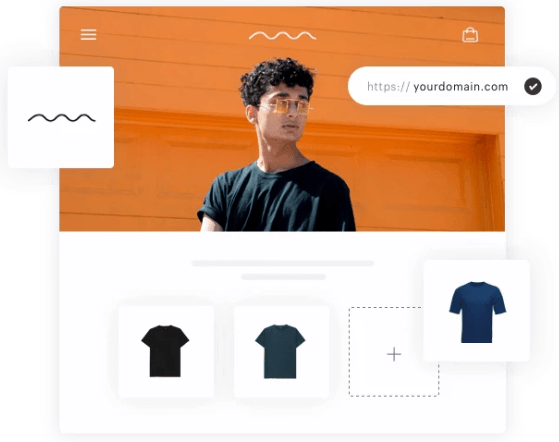
Cost of selling on Shopify
Shopify offers sellers a free 14-day trial, so you don’t need to enter a credit card when signing up on the platform.
When your free trial ends, you’ll need to select a pricing plan that matches your budget and business goals.
Choose from five plans:
- Shopify Lite: $9/month
- Basic Shopify: $29/month
- Shopify: $79/month
- Advanced Shopify: $299/month
- Shopify Plus: Custom pricing
Typically, small and medium-sized companies opt for the Shopify or Advanced Shopify plans, so you can expect to pay $79-$299/month to sell on Shopify.
Large businesses can sign up for Shopify Plus, but you’ll need to contact the company for a custom quote.
You may also opt for the Shopify Lite plan that allows you to sell on Facebook and interact with customers on Facebook Messenger. With this $9/month plan, you’ll add products to a website or blog and accept credit card payments.
Shopify ad options
Like Amazon, Shopify gives sellers access to several custom advertising options.
Google Smart Shopping
One of the first platforms to integrate Google’s new Smart Shopping campaigns, Shopify allows Google to pull product information from sellers’ stores.
Google then creates ads automatically and shows them to relevant audiences in places like Google search, Gmail, YouTube, and Google Display Network.
The seamless integration uses Google’s Smart technology to analyze results and optimize campaigns automatically, so you can maximize your paid ad budget.
Facebook Carousel ads
In addition to ads on Google, Shopify sellers can also run Facebook Carousel ads right in Shopify.
These ads include up to five products or images to engage customers and boost awareness of your offerings.
You can also track your Facebook ad results in Shopify.
Shopify shipping options
Shopify Shipping gives sellers access to pre-negotiated shipping rates and labels with shipping carriers based on your subscription plan.
In the U.S., sellers have access to USPS, UPS, and DHL Express.
Sellers in Canada have access to Canada Post.
Here’s an overview of the process:
- Choose shipping carriers you’d like to enable at checkout.
- Customers select their shipping service and speed at checkout.
- Receive payment for orders and shipping costs.
- Fulfill the order in Shopify and print the correct shipping label and packaging.
- Drop off the package with the appropriate carrier or schedule a pickup.
Shopify Shipping offers a suite of tools to aid with the shipping process via your Shopify admin. For example, you can purchase and send return labels to customers from your Shopify admin.
U.S. sellers can also schedule package pickups.
If you purchase UPS or DHL Express labels via Shopify Shipping, you can schedule a pickup from your Shopify admin.
When using Shopify Shipping, remember that the cost of shipping labels gets calculated using the weight of the products and packaging. You can enter this information in your Shopify admin easily, as well as purchase and print your shipping labels.
Final shipping costs depend on the distance and how quickly customers want to receive the products.
Pros and cons of selling on Shopify vs. your website
Pros:
- You can easily and quickly create a store: Easy-to-use, Shopify’s interface is built specifically for “technically challenged individuals.” That means you can launch your store and start selling without hassle. You can even use a custom domain name with Shopify.
- You can customize your storefront: Shopify’s online store builder and themes allow you to customize your online store. Create a store to match your brand and boost awareness of your business and products.
- You won’t have to update software and servers: Since Shopify is cloud-based and hosted, you won’t have to worry about upgrading or maintaining software or web servers. This also means you can run your business from anywhere with an Internet connection.
Cons:
- You have to pay fees: Like other platforms, Shopify charges sellers monthly. Depending on your goals and budget, it may make more sense to launch your own site or optimize an existing store.
- You have very basic content features: When advertising your products, content marketing is a huge asset for growing leads and sales. While Shopify offers built-in blogging software, its functionality is very basic — especially if you’re used to WordPress posting.
Additional Shopify resources
For more info on how to sell online with Shopify, check out these resources from WebFX.
- 4 Best Practices for Choosing a Shopify SEO Expert
- 6 Best Ecommerce Platforms for Small Businesses
- WebFX: Trusted Shopify Web Designers
Summary
Want an easy-to-use interface that lets you quickly boost online sales? Shopify is a good option for small and midsize businesses offering a variety of unique products!
Target Plus™
Target Plus™ is next up on our online marketplace ranking list.
A relatively new online marketplace, Target Plus™ allows third-party sellers to sell on Target.com.
The platform expands Target.com’s product offerings in categories like home furnishings, toys, electronics, and sporting goods.
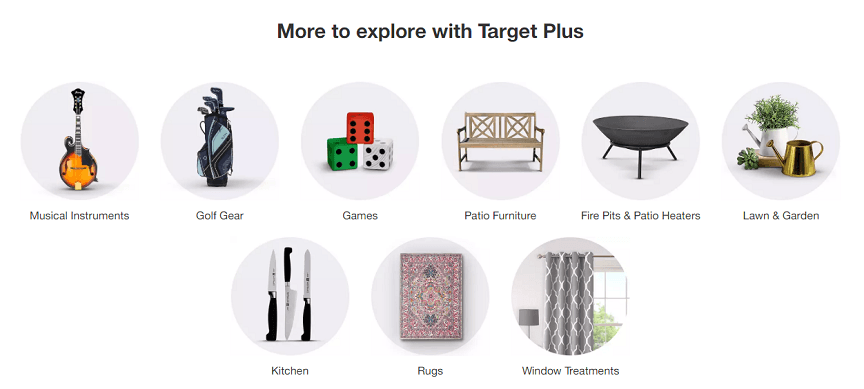
How to sell on Target Plus™
Unlike other online marketplace platforms, Target Plus™ is invite-only.
To become a Target supplier, you must uphold the company’s values, which include:
- Diversity
- Sustainability
- Education
- And others
If you want to boost your visibility with the Supplier Diversity team, you’ll need to fill out the Supplier Registration form.
You can also connect with a merchandising or sourcing team member. If selected, you will receive an email invite from a Target team member to set up an account on the Partners Online portal.
Then, Target will validate your company’s information during its approval and onboarding process.
You’ll also need to provide a list of brands you own or license from the trademark owner.
Cost of selling on Target Plus™
Target has not published information regarding Target Plus™ commissions and fees.
However, Target has stated that Target Plus™ sellers are responsible for shipping and other costs.
Target Plus™ ad options
Target’s advertising platform, Roundel (previously Target Media Network), allows companies to reach Target shoppers with custom advertisements.
Going beyond display ads, Roundel clients can advertise brands — even brands not sold in Target stores — on Target’s website and external channels like Pinterest, PopSugar, and NBCUniversal.
Currently, Roundel is used by businesses in financial services, automotive, travel, and more. Its clients include heavy hitters like Coca-Cola, Disney, Pepsi, and Mastercard.
That said, advertising with Roundel may not be the best fit for small and medium-sized businesses. Fortunately, WebFX specializes in helping SMBs expand their presence on online marketplaces like Target Plus™.
Check out our Target Plus™ management and optimization services to learn more.
Target Plus™ shipping options
While Target Plus™ sellers are responsible for shipping products, Target processes online and in-store returns.
Questioning if Target Plus™ selling could work for your business?
Here are some pros and cons of selling products online via Target Plus™.
Pros and cons of selling on Target Plus™ vs. your website
Pros:
- You can entice shoppers with benefits: Target Plus™ shoppers receive 5% off using a Target REDcard, free shipping, and easy in-store returns. These benefits, not available to SMBs selling on their own sites, can entice shoppers to buy — and become repeat purchasers.
- You have access to a broad audience: Target is the second-largest discount retailer in the U.S., with more than 1800 storefronts nationwide. When you sell on Target Plus™, you’ll receive access to Target’s massive audience, boosting brand awareness and sales for your business.
Cons:
- You have a high barrier to entry: Since Target Plus™ is currently invite-only, it’s difficult to get your products listed on this selling platform. You can submit a Supplier Registration form, but there’s no guarantee Target will approve your business.
- You must have a proven track record: Target prefers to work with businesses and products that have a proven track record — and you’ll need to uphold Target’s values. This means that if you’re a startup or even an established SMB, you may have a hard time gaining entry to the Target Plus™ marketplace.
Additional Target Plus™ resources
For more info on Target Plus™ selling and marketing, check out these resources from WebFX.
Summary
Want to expand your reach with the backing of a renowned brand? Target Plus™ is a good option for established businesses selling home furnishings, toys, electronics, or sporting goods!
eBay
Another top online marketplace in 2024, eBay allows consumers to buy and sell everything, from cars to electronics, sporting goods, and more. This powerhouse platform rakes in $35 billion in domestic sales each year — and it’s a household name across the globe.
How to sell on eBay
To start selling your products online with eBay:
- Create your account. Sign up for an eBay account to start selling.
- Navigate to “Sell.” Click “Sell” at the top of any eBay page or go to Sell your item.
- List products. Create and publish your product listings.
- Confirm your details and start selling. During this step, you can also add an automatic payment method for eBay fees.
Cost of selling on eBay
Individual eBay sellers can expect to pay several fees, including insertion and final value fees.
Insertion fee
Each month, eBay sellers get up to 50 zero insertion fee listings — or more if you have an eBay Store (more on that later).
After you’ve exceeded the allowance, you’re charged insertion fees, which include:
- Fee charged per listing and category
- Fee charged for the original listing and each time you relist your item
- Fee charged per listing if you create duplicate auction-style listings for identical items
- Fee charged only once per listing for listings with multiple items
Final value fee
Sellers are also charged a final value fee when an item sells.
This fee gets calculated as a percentage of the total sales amount, including any shipping and handling charges.
The amount eBay charges depends on the following factors:
- Item price
- Item format
- Item category
- Additional listing upgrades
- Seller conduct and performance
eBay Stores
Sellers also have the option to open an eBay Store to receive discounted fees and more free listings each month. Store owners have access to additional tools to manage and promote their businesses too.
To get started, you’ll need an eBay seller account with an automatic payment method on file.
If you want to open an eBay Store:
- Go to Account in My eBay.
- Select “Subscriptions.”
- Select “Chose a Store.”
- Find the Store type you’d like to subscribe to and choose “Select and review.”
- Select the subscription term (yearly or monthly) and enter a name for your Store.
- Select Submit order to purchase the Store subscription.
Store subscription plans from eBay start at $4.95/month (with a 1-yr plan) to $2999.95/month (with a 1-yr plan).
When opening an eBay store, you can choose from the following plans:
- Starter: $7.95/month, $4.95/year
- Basic: $27.95/month, $21.95/year
- Premium: $74.95/month, $59.95/year
- Anchor: $349.95/month, $299.95/year
- Enterprise: $2999.95/year
Take a look at eBay’s Store subscription fees to compare options and choose the one that’s right for your business.
eBay ad options
Like other online marketplaces, eBay allows sellers to meet specific objectives with ads.
These goals include:
Drive brand awareness
Build brand awareness for your company with these eBay ads:
- Home Page Takeover: Purchase valuable placement on eBay’s home page.
- Super Nova Takeover: Own high-impact, above-the-fold placements across eBay’s top pages for an entire day.
- eBay Audience Platform – Display and Video solutions: Expand your reach across premium partner sites and use eBay’s shopper data to optimize campaigns.
Drive consideration
Get shoppers to start thinking about your brand and products with these eBay ads:
- Category Homepage Takeover: Promote brand consideration as shoppers browse products on eBay.
- My eBay Billboard: Personally engage consumers with online billboard ads.
- Checkout Success Page: Reach highly-engaged customers who are ready to buy.
Drive conversions
Secure more sales and happy clients with these eBay ads:
- Search Results Page: Encourage action as consumers search for relevant products on eBay.
- Order Details Page: Reach millions of consumers at the point of purchase.
- Promoted Listings: Unlock placements on eBay’s most-viewed pages, including top search and product pages.

eBay shipping options
When selling on eBay, you’ll follow these steps to ship products:
Sellers on eBay can also attract buyers with Fast ‘N Free shipping.
To qualify, you need to meet these requirements:
- You and your buyer must both be located in the 48 contiguous U.S. states
- eBay can estimate the product’s delivery date as four business days or less based on your handling time, the delivery service you’ve offered, your location, and the buyer’s delivery address
- You offer free shipping as your default shipping option
- You don’t offer local pickup or freight as your first (default) shipping option
- The listing isn’t in Classified Ad format
With Fast ‘N Free shipping, if a guaranteed item arrives late, eBay will offer buyers one of the following options:
- Shipping cost reimbursement
- Voucher for a future eBay purchase
- Free return label if the seller accepts returns
To learn more, check out eBay’s shipping guidelines and seller shipping rates.
If you’re not sure if selling on eBay is right for you, here are some pros and cons to consider.
Pros and cons of selling on eBay vs. your website
Pros
- You can start selling fast: If you want to start selling quickly, eBay is a good option for you. The platform allows you to set up shop and gain traction for your products fast.
- You have access to a large audience: The second-largest U.S. marketplace, eBay receives 106 million unique visitors every month. Selling on eBay gives you access to a large market of consumers, ready to purchase from you.
Cons:
- You have to pay fees: Sellers on eBay can expect to pay a monthly subscription for an eBay store or insertion and final value fees when selling individual products. These costs can add up quickly, so evaluate your budget and profit margins before selling on eBay.
- You have intense competition: On eBay, there’s a lower barrier to entry, which also means you’ll face more competition on the platform. This means you’ll need to put extra effort into making your listings stand out to attract buyers and earn more revenue.
- You have to manage your store: Platforms like Amazon offer assistance with shipping and returns. But, with eBay, you’re in charge of managing your store — listing products, picking inventory, shipping items, and more.
Additional eBay resources
For more info on how to sell online with eBay, check out these resources from WebFX.
Summary
Want quick access to a large audience of buyers? eBay is a good option for businesses selling a variety of products, from electronics to second-hand items!
Etsy
Etsy is next on our list of the top online marketplaces in 2024.
An online marketplace for handmade, vintage, and craft supply goods, Etsy is an excellent option for sellers catering to those niches. With 39.4 million active buyers on the platform, you can quickly and easily expand your reach and sell more products online with Etsy.
How to sell on Etsy
To open an Etsy shop, follow these steps:
- Sign up to sell: Be sure to check Etsy’s Seller Policy to make sure your products meet the requirements.
- Set your preferences: Select your shop’s language, country, and currency.
- Enter your shop name: Choose a shop name that reflects your business and brand.
- Stock your shop: Start listing products you want to sell.
- Choose your payment method: Etsy sellers can receive payment via Etsy payments, PayPal, check or money orders
- Add a credit card: Depending on your country, you may have to enter a credit card to open your shop.
- Customize your shop: You can add a bio, set policies. create shipping profiles, write an about section, use Etsy’s social media tool, and more.
Once your shop is open, you can start selling your products!
Cost of selling on Etsy
Wondering how much it costs to sell on an online selling platform like Etsy?
Etsy sellers can expect to pay several fees, including:
- Listing fee: $0.20 per listing.
- Auto-renew fee: $0.20 per auto-renewed listing. Etsy listings expire after four months.
- Multi-quantity fee: $0.20 per each additional quantity when selling multiple quantities of a listing in one transaction.
- Private listing fee: $0.20 per private listing.
- Shipping label fee: Depends on selections when purchasing shipping labels.
- Shipping transaction fee: 5% of an item’s listed shipping costs.
- Transaction fee: 5% of total item costs (plus shipping and gift wrap) in the designated listing currency.
- Square manual fee: $0.20 per transaction when you sell items in-person using Square, and they are not synced from your Etsy shop inventory.
Check out Etsy’s complete list of selling fees to learn more.
Etsy ad options
Etsy allows sellers to advertise products on the Etsy site, including in its search results, and on Google.

Follow these steps to get started with Etsy ads:
- Navigate to Etsy’s Shop Manager.
- Click “Marketing.”
- Click “Advertising.”
- Set your daily budget (the maximum amount you’re willing to spend on advertising per day). Etsy’s default minimum daily budget is $1. Your maximum daily budget will depend on your average spend, current payment status, and payment history.
- Click “Start advertising.”
By default, starting an ad campaign on Etsy advertises all your listings automatically.
If you want to update which listings you advertise, follow these steps:
- From Advertising, click “Change advertised listings.”
- Check only the listings you want to advertise.
- Click “Save changes.”
On Etsy, you get charged when your ad gets clicked. Etsy calculates your total cost-per-click (CPC) each day and adds it to your payment account.
Etsy shipping options
Etsy makes shipping easy and affordable for sellers with shipping labels, calculated shipping, and shipment tracking.
Like Shopify, Etsy offers shipping labels that allow you to sell directly from your shops via:
- USPS
- FedEx
- Canada Post
Even better, you can save up to 30% on shipping with Etsy Shipping Labels.
When you purchase a shipping label, Etsy marks the item shipped automatically. Just print the label, package, and send the item.
To start shipping on Etsy:
- Create shipping profiles to add shipping costs to items automatically.
- Add tracking options to put customers at ease.
For more info about how to get started, check out Etsy’s shipping page.
Not sure if you should sell on Etsy or your website?
Here are some pros and cons of selling products online with Etsy.
Pros and cons of selling on Etsy vs. your website
Pros:
- You can reach a niche audience: If you sell handmade, vintage, or craft supply goods, Etsy can instantly connect you with your target market. Since the platform caters to a specific niche, there’s a good chance your audience browses Etsy looking for the products you offer.
- You have streamlined shipping options: Etsy makes it easy to package and ship your products. If you’re worried about shipping rates, take advantage of Etsy’s shipping discounts to make the process as stress-free as possible.
Cons:
- You have to pay fees: Again, Etsy charges sellers a range of fees. Calculate your budget and profit margins when selling on Etsy to make sure you’re getting a return from using the online marketplace.
- You have limited ad options: Compared to other platforms, Etsy’s ads lack customization and targeting options. If you’re looking for a no-fuss solution, Etsy ads can work for you, but you will likely need more advanced options to drive the results you want.
Additional Etsy resources
For more info on Etsy selling and marketing, check out these resources from WebFX.
Summary
Want to target niche buyers and enjoy streamlined shipping? Etsy is a great option for sellers of handmade, vintage, and craft supply goods!
Sears Marketplace
Another popular online marketplace is Sears Marketplace. This marketplace allows SMBs to sell products on Sears.com and in kiosks in Sears stores.
With millions of Sears.com members, you can access a broad audience of ready-to-buy shoppers.
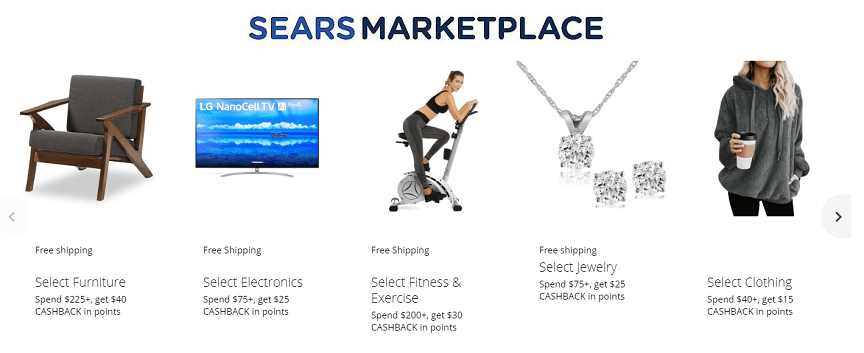
How to sell on Sears
To start selling on Sears.com, you’ll need to:
- Fill out your Sears Marketplace application with information about your business and products.
- Verify your address. To sell on Sears Marketplace, you will need a U.S.-based business address.
- Verify business details. You’ll also need to ensure you have an EIN or SSN registered to a U.S.-based address.
Sears does not guarantee return contact for forms. They will not prioritize incomplete forms either.
Cost of selling on Sears
Sears.com sellers get charged a $39.99 monthly program fee, as well as a commission for each item sold.
Commission fees depend on product categories and range from 8-20%. For instance, if you sell clothing, expect to pay a 15% commission fee for each product sold.
If you opt for FBS, you’ll have access to a pay-as-you-go model with no long-term commitments. This means you’ll only pay for what you store and ship.
Check out the shipping section below to learn more about FBS options and pricing.
Sears ad options
Sears also lets sellers create compelling ads to reach Sears.com shoppers.
With 15 million unique visitors each month, Sears.com is valuable territory for businesses looking to boost brand awareness and purchases.
Advertising on Sears gives you numerous options, including:
- Display ads: Connect with your target audience with display ads on department pages. You can also create display ads on Sears’ home page — it attracts one million pages views each day!
- Featured product ads: Highlight specific products with ads in visible locations based on shopper searches and navigation.
- Brand showcases: Create multi-channel experiences that earn you qualified web traffic with brand showcases, which feature a hero image, promotional banner text, and more.
Check out the Advertise with Sears page for a full overview of ad options and pricing.
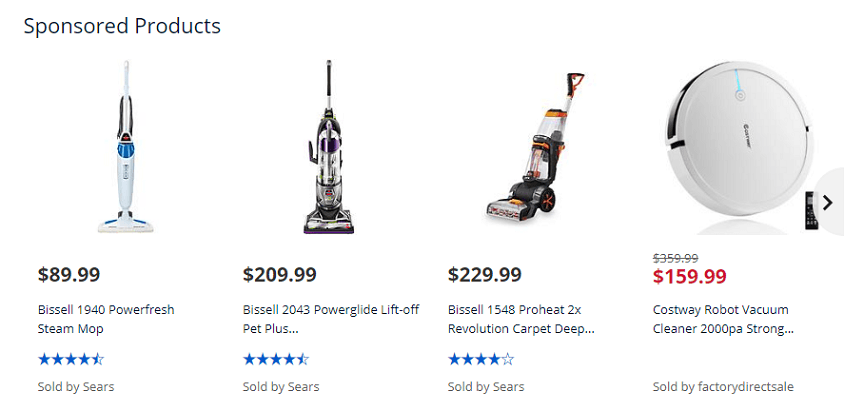
Sears shipping options
Sears discontinued its fulfillment program, which was called Fulfilled by Sears, in 2024. While Sears processes your orders and provides you with the information you need to fulfill your orders, you’ll need to ship the orders through your own delivery methods.
Curious about whether Sears is the right option for selling and shipping your products? Check out the pros and cons of this top online marketplace of 2024.
Pros and cons of selling on Sears vs. your website
Pros:
- You don’t have a long-term commitment: With Sears.com selling and FBS solutions, you can cancel at any time, and you aren’t obligated to fulfill a long-term commitment. Feel free to try this online marketplace and see if it works for your business.
- You have access to a large audience of buyers: As mentioned, Sears.com receives more than 15 million unique visitors each month. If you want quick access to buyers, Sears.com selling and FBS are great options.
- You have an easy-to-use order management interface: For SMBs, it’s a straightforward process to set up your account and start selling on Sears.com — and the platform’s easy-to-use interface is great for sellers without a lot of technical knowledge.
Cons:
- You have more competition: When selling on Sears.com, you encounter competitors in product categories you offer, as well as products sold by Sears. This means you’ll have to keep a close eye on your pricing and regularly optimize listings to get your products noticed.
- You must have a U.S.-based business address: To sell on Sears.com, you will need a business address based in the U.S. While Sears does offer options for international sellers, there is a higher barrier to entry.
Summary
Want instant access to an audience of ready-to-buy shoppers? Sears is a good option for businesses selling appliances, home goods, electronics, and more!
Alibaba
A Chinese ecommerce company, Alibaba offers online marketplace, payment, and cloud computing services.
While Alibaba isn’t a U.S.-based selling platform, we think it’s worthy to note on our list of the best online selling sites. After all, it dominates 80% of China’s online shopping market and boasts the equivalent $1 trillion in online site transactions.
How to sell on Alibaba
To determine if it’s better to sell on Alibaba or your website, let’s look at how to sell on the platform.
Start selling on Alibaba with these steps:
- Create your account on Alibaba.com.
- Start listing products. Visit My Alibaba to get started.
- Secure your trades. Place a Trade Assurance order with online buyers to better protect your trades.

Cost of selling on Alibaba
Alibaba offers a Free Membership plan that lets sellers:
- List up to 50 products.
- Subscribe to Trade Alert to get the latest buyer requests in your mailbox.
In addition to Alibaba’s free option, sellers can opt to pay for a Global Gold Supplier Membership to earn more buyers and buyer trust.
Global Gold Suppliers choose from the following packages:
- Basic: $117/year, plus $1000 startup fee
- Premium: $117/ year, plus $2800 startup fee
View Alibaba’s packages and pricing to learn more.
Alibaba ad options
Alibaba also offers ad options to help your products gain exposure on the site.
To start advertising on Alibaba:
- Sign in to My Alibaba
- In the “Products” section, click “Display New Products.”
- Enter the product name you want to advertise and click “Search.”
- Select the matching category from the pull-down menu and select “Next.”
- Complete the form and click “Submit.”
Alibaba allows Global Gold Suppliers to post unlimited products.
In addition, you can advertise in Trade Alert emails — Alibaba’s email updates on trending products, buying requests, and supplier info.
If you want to advertise via Trade Alert emails:
- Sign in to My Alibaba.
- In the “Products” section, click “Display a New Product.”
- Complete the form and click “Submit.”
Alibaba shipping options
Alibaba Logistics provides shipping services to sellers in select countries — and you can choose from Air Express and Sea Freight options.
Air Express
This service offers cost-effective shipping to the U.S. in 5-7 business days, as well as online order tracking.
Sea Freight
You can also choose from two sea freight shipping options:
- Less-than-Container Load (LCL): LCL is perfect for people looking to save money with ocean freight, but don’t have enough volume to fill a shipping container.
- Full Container Load (FCL): The best choice for high-volume orders, FCL orders fill one or more shipping containers.
For businesses in the U.S., Alibaba offers exclusive access to shipping experts.
Learn more and schedule a call to find out if Alibaba Logistics is right for your business.
Still not sure if Alibaba is the best platform to sell online for your business?
Check out these pros and cons of Alibaba selling.
Pros and cons of selling on Alibaba vs. your website
Pros:
- You have access to a large audience: Alibaba has 654 million active buyers each year — and selling on China’s top ecommerce platform expands your audience instantly.
- You can reach B2B and B2C buyers: Whether you sell apparel or machinery, Alibaba allows you to reach an audience of B2B and B2C buyers ready to purchase your products.
Cons:
- You have more logistical hurdles: Since Alibaba operates in China, you’ll likely encounter some logistical hurdles when selling on the platform. You’ll need to pay close attention to pricing and exchange rates to ensure you earn the best possible return.
- You may pay more for shipping: Depending on the location of your buyers, you may end up paying more to ship internationally.
Summary
Want access to millions of B2B and B2C buyers, ready to purchase your items? Alibaba is a good option for businesses selling everything from apparel to machinery!
Rakuten
A top global online marketplace, Rakuten boasts 1.3 billion members across the globe.
While not based in the U.S., Rakuten features 12 million U.S. members.
How to sell on Rakuten
If you want to become a Rakuten marketplace merchant, you’ll need to:
- Apply: In the application, you’ll provide information about your business, annual sales, product categories, and more.
- Get approved: Once approved for this online selling site, you’ll receive support from Rakuten’s Launch Team to guide you through the onboarding process, which typically takes three to 10 business days, depending on your catalog size.
Brands currently selling on Rakuten include:
- Lenovo
- Puma
- Office Depot
- And more
For more info about selling on Rakuten, check out its FAQ page.
Cost of selling on Rakuten
Rakuten charges sellers $39/month, plus category commission and $0.99 for every item sold.
Commission fees range from 8-15%, depending on the product category. If you sell electronics on Rakuten, you can expect to pay an 8% commission fee, while selling clothing will cost you 15% commission.
Rakuten ad options
Like most other third-party ecommerce platforms, Rakuten offers advertising options to boost brand exposure and conversions.
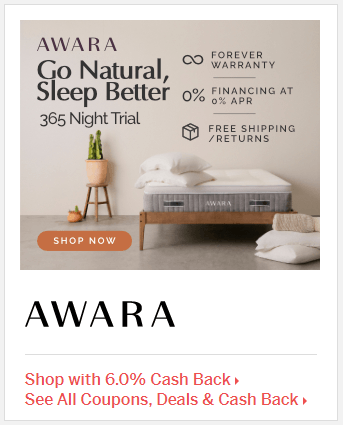
If you sell on Rakuten, you can increase exposure with:
- Homepage ads viewed by millions of unique visitors each month
- Rakuten Cash Back promotions
- Promotion via Rakuten’s mobile app
- Boosted awareness of your best offers and promotions
- Targeted email and Cash Back campaigns
- And more
To start advertising on Rakuten Marketplace or the Rakuten Marketplace Affiliate Program, fill out a contact form.
Rakuten shipping options
As a Rakuten seller, you choose the shipping options available to your customers — and you can choose from four shipping speeds.
Rakuten sellers can pick from the following shipping companies and options:
- FedEx
- FedEx Smart Post
- Home Direct USA
- SEKO Worldwide
- UPS
- UPS Mail Innovations
- USPS
- Vitran
- And more
When people purchase from you on Rakuten, you’ll have two days to ship their products. Keep in mind that Rakuten bases its selling fees on the entire transaction cost, including shipping and handling.
Pros and cons of selling on Rakuten vs. your website
Pros:
- Your shoppers have access to Rakuten’s loyalty program: Rakuten members receive Rakuten Super Points® on all purchases. They can redeem those points to save on future purchases, which keeps them coming back to purchase from you.
- You can offer shopper incentives: Rakuten shoppers receive up to 40% cash back at 2500+ stores or via PayPal. These incentives encourage shoppers to purchase and remain loyal customers.
- You can customize your storefront: When you sell on Rakuten, you can customize your storefront to match your brand identity and boost awareness of your business.
Cons:
- You have logistical hurdles: Like Alibaba, Rakuten is not based in the U.S. — so you may experience some logistical setbacks when selling on the platform.
- You must be a U.S.-based business: Rakuten only supports selling in the U.S., and international sellers must meet specific requirements.
- You have pricing restrictions: When selling on Rakuten, you are required to price items, including shipping costs, at the same price you sell them on your ecommerce site and other channels.
Summary
Want to entice shoppers with exclusive deals and promotions? Rakuten is a good option for clothing, electronics, and household goods sellers looking to inspire loyal customers!
Facebook Marketplace for Business
Facebook Marketplace — commonly used to buy and sell items like furniture, clothes, and even cars — features 800 million monthly users in 70 countries.
Though the platform is popular among individual sellers, Facebook has started to roll out Marketplace for Business — a feature for SMB sellers.
Marketplace for Business allows you to:
- Show inventory for retail items, home rentals, vehicles, and event tickets
- Advertise your store or products on Marketplace, even if you don’t sell directly on the platform
- Display new or refurbished items from your Facebook Page shop on Marketplace for free and allow customers to buy without leaving Facebook
How to sell on Facebook Marketplace for Business
To list ecommerce inventory on Marketplace for Business, you’ll need to work with one of the following listing partners:
- BigCommerce
- ChannelAdvisor
- CommerceHub
- Feedonomics
- Quipt
- ShipStation
- Shopify
- Zentail
Facebook recommends contacting a listing partner directly to express interest in selling your products on Marketplace for Business.
All Marketplace listings must comply with Facebook’s Commerce Policies and Community Standards.
It’s important to note —Facebook is gradually introducing Marketplace for Business, so it may not currently be available to you.
Cost of selling on Facebook Marketplace for Business
A perk of using this selling platform — Facebook does not charge to list inventory on Marketplace.
However, you may encounter fees working with Facebook’s listing partners.
Facebook Marketplace for Business ad options
With Facebook Ads Manager, you can create ads to display in Marketplace.
To create a Marketplace ad:
- Go to Ads Manager and choose Brand awareness, Reach, Traffic, Video views, Lead generation, Event responses, Messages, Conversions, Catalog sales, or Store traffic as your ad objective.
- Choose your Destination.
- Choose Your Audience and define your targeting.
- Choose Automatic Placements or Edit Placements. Facebook recommends Automatic Placements. Marketplace isn’t available as a single ad placement, and your ad campaign must include News Feed, so keep that in mind if you choose Edit Placements.
- Set your Budget and Schedule.
- Choose your ad’s Creative Format. The recommended video and image specs are the same as News Feed ads.
- Click Done and Place Order.
After your ads are approved, they’ll appear as users browse Marketplace.
Facebook Marketplace for Business shipping options
Marketplace for Business sellers are responsible for shipping inventory.
To sell on Marketplace for Business:
- Orders must be shipped within 3 days and received within 7 days.
- Returns must be accepted within 30 days.
Pros and cons of selling on Facebook Marketplace for Business vs. your website
Pros:
- You can display items from your Facebook Page shop for free: With Facebook Marketplace for Business, you can easily show products from your Facebook Page shop to boost awareness and sales.
- You can allow people to purchase without leaving Facebook: Facebook Marketplace for Business allows customers to purchase without leaving Facebook. This streamlines the conversion process and makes it easier for people to buy from your business.
- You can advertise your store: To reach more shoppers, you can create custom advertisements to display in Facebook Marketplace. This is a great way to get more eyes on your products and ultimately earn more sales online.
Cons:
- You have greater competition: Keep in mind that you’ll compete directly with other sellers on Facebook Marketplace for Business, especially since Marketplace for Business supports limited product categories.
- You have to pay listing partner fees: While Facebook doesn’t charge to sell on Marketplace for Business, you may encounter fees working with a listing partner.
Additional Facebook Marketplace for Business resources
For more information and to start selling on Facebook Marketplace for Business, check out these resources from WebFX.
Summary
Want to boost awareness of your products and allow people to buy directly on social media? Facebook Marketplace for Business is a good option for selling retail items, home rentals, vehicles, and event tickets.
Start Selling on Facebook Marketplace
Your own website
Now that we’ve looked at the top third-party marketplaces, it’s time to consider creating and selling on your own site.
For many businesses, creating and selling on their own ecommerce websites yields the best return. Since 74% of small business websites don’t have ecommerce functionalities, there’s a significant opportunity for you to move into the online selling space using your site.
How to sell on your website
To start selling products online via your site, you’ll first need to create or update your website.
Follow these steps to get started selling on your site:
- Select your website host.
- Register your domain name.
- Design your ecommerce site.
- Get your SSL certificate to secure your site.
- Set up a merchant account to start accepting online payments.
- Establish your pricing and start listing products.
- Create a plan for managing your inventory and shipping products.
- Promote your site with digital marketing services.
Designing and launching your ecommerce store is a daunting task, but WebFX can guide you through every step of the process. Contact us today to speak with an expert and start selling from your custom online storefront.
Cost of selling on your website
Selling on your own site requires an upfront investment, but for many SMBs, it’s the best long-term option.
When creating your site, you’ll encounter several fees, including:
Website design, development, and maintenance
On average, you can expect to pay $12,000 – $150,000 to design and launch a custom ecommerce site. You’ll also need to invest in routine maintenance, which can range from $35 – $5000 per month.
Ultimately, the total cost of selling on your site depends on several factors. For a custom estimate, check out our website cost calculator.
Ecommerce SEO
If you want to drive long-term results with your ecommerce store, we also recommend investing in an SEO strategy.
WebFX offers ecommerce SEO services. In the last five years, we’ve generated over $6 billion in revenue for clients and driven more than 24 million leads for their businesses.
At WebFX, we understand the importance of creating websites that not only look great, but also function well and rank at the top of search results.
When you choose us as your ecommerce partner, you can rest assured we’ll earn you the best possible results — and you’ll enjoy more site traffic, leads, and online revenue.
Create My Custom Ecommerce Site
Ad options for your website
When selling on your own website, you can choose to run paid ads on platforms like Google Ads, as well as social media sites, to boost traffic to your website.
PPC ads appear at the top of search results — above organic listings. And they can help your SMB boost brand awareness, leads, and revenue.
Advertising on social media expands your reach and connects your business with a qualified audience — people most likely to purchase from your online site.
If you’re launching a new site, PPC ads can help you gain qualified leads immediately, while you work to establish your organic site rankings with SEO.
To get the best possible ROI from your paid ad campaigns, we recommend consulting a PPC expert.
At WebFX, our PPC specialists will take a deep dive into your goals and budget. We’ll also create a custom-tailored strategy to help you create and manage result-driving ads.
Shipping options for your website
When selling on your own site versus an online selling site, you’re responsible for fulfilling and shipping all orders.
Here are some things to consider:
- Shipping rates and methods: You can choose to pass the full cost of shipping on to customers or offer free, flat-rate shipping to absorb some of the shipping fees.
- Product size and weights: Recording product weights will help you establish accurate shipping prices, so you can provide value to customers, while still earning the best return.
- Packaging: SMBs can order packaging from USPS, UPS, or DHL — or you may choose to invest in branded packaging for your ecommerce business.
Keep in mind, you’ll also need to create a return policy and provide customer service to shoppers.
Pros and cons of selling on your own website
Pros:
- You have greater pricing control: Selling on your site gives you full control over your pricing. While it’s wise to monitor competitors’ online pricing, you have greater autonomy when setting your pricing, sales, and discounts.
- You eliminate competitors: When you have your own site, you won’t have to worry about other competitors selling on the same platform. With online marketplaces, you’ll have to compete directly with other sellers and the third-party’s own products.
- You won’t have to pay a third-party platform: When you own your website, you may choose to pay for services like ongoing SEO and website maintenance. However, you’re investing that money into your website. You also don’t have to worry about paying regular fees to a third-party platform.
Cons:
- You must have technical expertise: Setting up an ecommerce site takes a great deal of technical know-how. Unless you work with a web design agency, you’ll need to set up and manage your website’s hosting, integrations, site security, payment options, and more. You’ll also need to perform regular maintenance to keep your site operating effectively.
- You may not get enough web traffic: For many SMBs, especially those with new websites, it’s challenging to drive consistent, qualified traffic to your site. You can have the most beautifully designed site, but if nobody can find it online, you won’t drive any sales.
- You need to work harder to earn consumer trust: Depending on your business, you may also lack the reputation or social proof necessary to inspire purchases. A household name like Amazon doesn’t back your website, so you’ll need to work hard to instill trust in shoppers and keep them coming back to your ecommerce store.
Additional resources for selling on your own site
For more info on creating your ecommerce site, check out these resources from WebFX:
- Award-Winning Web Design Services
- Ecommerce Web Design That Drives Results
- Our 12 Pro-Grade Web Development Solutions
- Ecommerce SEO Services
- How Much Should a Website Cost?
Summary
Want full control of your pricing and online sales platform? Creating your own website is a good option if you want to take the reins and position your business for long-term success!
Table of Contents
- Where to Sell Online: Inside the 11 Best Online Marketplaces
- Amazon Marketplace
- How to Sell on Amazon Marketplace
- Cost of Selling on Amazon Marketplace
- Amazon Ad Options
- Amazon Shipping Options
- Pros and Cons of Selling on Amazon vs. Your Website
- Additional Amazon Marketplace Resources
- Summary
- Walmart Marketplace
- How to Sell on Walmart Marketplace
- Cost of Selling on Walmart Marketplace
- Walmart Marketplace Ad Options
- Walmart Marketplace Shipping Options
- Pros and Cons of Selling on Walmart Marketplace vs. Your Website
- Additional Walmart Marketplace Resources
- Summary
- Shopify
- How to Sell on Shopify
- Cost of Selling on Shopify
- Shopify Ad Options
- Shopify Shipping Options
- Pros and Cons of Selling on Shopify vs. Your Website
- Additional Shopify Resources
- Summary
- Target Plus™
- How to Sell on Target Plus™
- Cost of Selling on Target Plus™
- Target Plus™ Ad Options
- Target Plus™ Shipping Options
- Pros and Cons of Selling on Target Plus™ vs. Your Website
- Additional Target Plus™ Resources
- Summary
- EBay
- How to Sell on EBay
- Cost of Selling on EBay
- EBay Stores
- EBay Ad Options
- EBay Shipping Options
- Pros and Cons of Selling on EBay vs. Your Website
- Additional EBay Resources
- Summary
- Etsy
- How to Sell on Etsy
- Cost of Selling on Etsy
- Etsy Ad Options
- Etsy Shipping Options
- Pros and Cons of Selling on Etsy vs. Your Website
- Additional Etsy Resources
- Summary
- Sears Marketplace
- How to Sell on Sears
- Cost of Selling on Sears
- Sears Ad Options
- Sears Shipping Options
- Pros and Cons of Selling on Sears vs. Your Website
- Summary
- Alibaba
- How to Sell on Alibaba
- Cost of Selling on Alibaba
- Alibaba Ad Options
- Alibaba Shipping Options
- Pros and Cons of Selling on Alibaba vs. Your Website
- Summary
- Rakuten
- How to Sell on Rakuten
- Cost of Selling on Rakuten
- Rakuten Ad Options
- Rakuten Shipping Options
- Pros and Cons of Selling on Rakuten vs. Your Website
- Summary
- Facebook Marketplace for Business
- How to Sell on Facebook Marketplace for Business
- Cost of Selling on Facebook Marketplace for Business
- Facebook Marketplace for Business Ad Options
- Facebook Marketplace for Business Shipping Options
- Pros and Cons of Selling on Facebook Marketplace for Business vs. Your Website
- Additional Facebook Marketplace for Business Resources
- Summary
- Your Own Website
- How to Sell on Your Website
- Cost of Selling on Your Website
- Ad Options for Your Website
- Shipping Options for Your Website
- Pros and Cons of Selling on Your Own Website
- Additional Resources for Selling on Your Own Site
- Summary
Related Resources
- B2C Marketplaces
- Best Ecommerce Platforms for Small Businesses
- Enterprise
- Learn About Online Marketplaces
- Online Marketplaces for Ecommerce Businesses
- Online Marketplaces Glossary
- Should I Sell on Walmart or Target? Which Online Marketplace is Best for Selling?
- What is an Online Marketplace?
- What is Sears Marketplace? [+5 Benefits of Sears Marketplace]
- 14 Best Places to Sell Online in 2024
Find Us Driving Revenue Nationwide
- Internet Marketing Agency
- Internet Marketing Prices for Every Strategy
- Marketing Operations Services
- Measure Your Product Catalog’s ROI with Ecommerce PIM
- Online Press Release Services: Promote & Grow Your Company
- Performance Marketing Agency
- Performance Marketing Services
- Professional Marketing Company
- Professional Marketing Services: Grow Your Revenue
- AI Marketing Services
One Size Does Not Fit All
Select an ecommerce marketing service to view custom rates for your campaign
Ecommerce Web Design
Get a custom ecommerce website that is mobile-friendly, plus follows SEO best practices so more people can find your store.
Ecommerce PPC
Advertise on Google and Bing with ads built for ecommerce stores by a dedicated ecommerce PPC specialist.
Ecommerce SEO
Selling products online? Want to keep inventory moving? Ecommerce SEO is the longterm strategy that keeps your warehouse busy!
What is the best platform to sell online in 2024?
The million-dollar question: What is the best platform sell online? A top online marketplace or your own website?
Unfortunately, there isn’t a one-size-fits-all answer — but hopefully, our online marketplace guide helps you get started. Depending on your business, goals, and budget, you may get a better return selling on an online marketplace, your own site, or a combination of online selling platforms.
Choosing where to sell online is a big decision — and it can make or break your business.
At WebFX, we understand the importance of fully researching and vetting all options to find the perfect online selling platforms for your business. That’s why we recommend consulting ecommerce specialists, like the WebFX team.
We specialize in creating ecommerce websites that not only look great, but also rank at the top of search results.
Plus, we help companies like yours take advantage of the best online selling sites, like Amazon and Walmart Marketplace, so you can earn more sales through more online channels.
Contact us online or give us a ring at 888-601-5359 to learn more about our ecommerce web design services, as well as marketing services for online marketplaces like Amazon, Walmart Marketplace, and Facebook Marketplace.
FAQs about selling products online marketplaces
Do you still have questions about using selling sites and online marketplaces like Etsy and Amazon?
Browse our FAQs.
What is an online marketplace or online selling platforms?
An online marketplace is an ecommerce platform that offers different products from different sellers. Amazon, Google Shopping, Walmart Marketplace, and Etsy are all examples of online marketplaces that businesses and individual sellers use.
Why use online marketplaces to sell products?
When selling products online, online marketplaces offer a unique advantage.
Many, like Amazon, eBay, and Walmart Marketplace, have an established audience of shoppers. Joining one of these online selling platforms allows your business to reach a massive audience of ready-to-buy consumers, which can translate to more online orders and sales.
Another advantage of these online selling sites is that they offer quick onboarding. That means your business can create an account, upload its products, and start selling fast. For example, platforms like Amazon provide bulk product upload options.
Overall, it’s smart to take advantage of online marketplaces to sell your products because they offer access to a broad audience that’s looking to buy. Plus, they have an established infrastructure and quick onboarding process for new sellers.
That doesn’t mean you shouldn’t sell on your website — only that you should consider opening another channel for generating orders.
[Bonus] Statistics on the Top U.S. online marketplaces
U.S. online marketplaces account for $2.67 trillion in sales, making digital retail platforms a valuable investment for small and medium-sized businesses (SMBs). When deciding how and where to sell online in 2024, you’ll want to consider these powerhouse platforms.
Let’s look at some stats about America’s top-ranking online marketplaces:
Amazon
- $295 billion in Amazon Marketplace sales
- 1.9 million active sellers on Amazon Marketplace worldwide
- 150 million monthly unique visitors in the U.S. alone
- 1+ million U.S.-based SMB sellers
- 54% of paid units on Amazon are sold by third-party sellers
Walmart
- $13-15 billion in annual online sales
- 80 million products on Walmart.com
- 100 million unique Walmart.com visitors each month
- 35+ product categories
- 2nd largest online retailer in the U.S.
Shopify
- $100+ billion total sales on the platform
- 218 million buyers on the platform
- 820,000 merchants sell on Shopify
- 5300+ Shopify Plus businesses
- 69% of orders from mobile devices
Target
- $5 billion in annual online sales
- 197 million website visits in the past six months
- 1800 storefronts nationwide
- 3rd largest discount retailer in the U.S.
- 29% growth in online sales in 2020
eBay
- $90 billion in sales in 2020
- 250 million promoted eBay listings
- 182 million active buyers
- 106 million monthly unique visitors
- #1 ranking in survey of online sellers
Etsy
- Over 10 billion U.S. dollars in annual gross merchandise sales volume (GMV)
- Nearly 82 million active Etsy buyers
- Over 4 million active Etsy sellers
- 62% of Etsy sellers are based in the U.S.
- $4.7 billion contributed to the U.S. economy from Etsy SMB sellers
Sears
- 2.4 billion page views a year
- 15 million unique monthly visitors
- 20 major merchandise categories
- 3rd largest online mass merchant
Alibaba
- 779 millionannual active consumers
- The equivalent of more than $1 trillionin annual gross merchandise volume (GMV) in China
- $25 billion IPO
- 721 million Alibaba smartphone app users
- 80% ownership of China’s online shopping market
Rakuten
- The equivalent of $31 billion in gross merchandise sales
- 1.4 billion members worldwide
- 12 million U.S. Rakuten members
- 40% cash back at 2500+ stores
- 30 countries and regions served
Your own website
- $861 billion in U.S. ecommerce sales
- 95% of Americans shop online at least once per year
- 80% of U.S. Internet users have purchased online
- 51% of Americans prefer to shop online
- 43% of ecommerce traffic comes from Google search
Related Resources
- B2C Marketplaces
- Best Ecommerce Platforms for Small Businesses
- Enterprise
- Learn About Online Marketplaces
- Online Marketplaces for Ecommerce Businesses
- Online Marketplaces Glossary
- Should I Sell on Walmart or Target? Which Online Marketplace is Best for Selling?
- What is an Online Marketplace?
- What is Sears Marketplace? [+5 Benefits of Sears Marketplace]
- 14 Best Places to Sell Online in 2024
Find Us Driving Revenue Nationwide
- Internet Marketing Agency
- Internet Marketing Prices for Every Strategy
- Marketing Operations Services
- Measure Your Product Catalog’s ROI with Ecommerce PIM
- Online Press Release Services: Promote & Grow Your Company
- Performance Marketing Agency
- Performance Marketing Services
- Professional Marketing Company
- Professional Marketing Services: Grow Your Revenue
- AI Marketing Services
WebFX is an online marketplace expert
We’ve designed and launched more than 1,600client websites — and we specialize in online marketplace management.
In addition to custom website design and development, we offer result-driving marketing services for the following online marketplaces:
- Amazon
- Walmart Marketplace
- Target Plus™
- Shopify
- And more!
Start creating and optimizing your custom storefront today – contact WebFX or give us a call at 888-601-5359.











